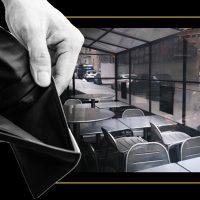Mayor Bill de Blasio said Wednesday that the city was “waiving all the rules” regarding sidewalk dining — but it’s a little more complicated than that.
“We just said, whatever the rules were in the past, we’re waiving all the rules,” de Blasio said at a virtual conference of mayors. “All you have to do is tell us you want to do it and you’re in. You can use the sidewalks or part of the sidewalks around your restaurants, you can take up the curb and put tables there and put up dividers to keep you separated from the traffic.”
As of Wednesday morning, 4,800 restaurants across the city had applied to participate in the sidewalk and street dining greenlighted during the second phase of reopening — a 50 percent increase from 3,200 applicants on Monday.
And that’s just the start. The city says it is accepting new applications daily. Now, the mass number of restaurants looking to claim their section of the sidewalk raises concerns over what enforcement will look like.
Read more


Restaurateurs have already gone beyond what may be allowed by the city, as some have creeped over other retailers’s frontage to use more sidewalk space. A spokesperson told The Real Deal that such practices are not allowed, even if eateries receive permission from their neighbors.
As of now, enforcement of open restaurants is complaint-based, according to a city representative, meaning that restaurants will only be inspected after an employee or guest calls 311 to inform the city that an eatery is not observing social distancing guidelines.
“We’ll be on hand to provide education and enforcement where it’s necessary, but restaurants don’t want New Yorkers getting sick, either — and we know they’ll do their part to stop the spread of COVID-19,” Mitch Schwartz, the deputy press secretary for the office of the mayor, said in an email.
Although the city has released mandatory best practices, the application, which consists of a one-page Google questionnaire, is straightforward. Restaurant owners fill in their business name, address, specify if they plan on putting tables on the sidewalk or in the street and they’re on their way for approval.
The current process prevents restaurateurs, many of whom have faced an existential crisis under the shutdown, from being “bogged down in bureaucracy,” said New York City Hospitality Alliance Executive Director Andrew Rigie.
Indoor dining is currently set to begin on July 6. In the meantime, phase two allows diners to walk through a restaurant to access the outdoor area, but does not allow seating to be placed under a fixed roof. So, restaurants that have patios with year-round coverings, and indoor dining in rooms with open floor-to-ceiling windows or garage doors, should be out of the picture for now.
Restaurants’ takeover of city streets is also expected to grow as de Blasio announced Friday that 10 to 20 corridors citywide will be shut to traffic and approved for expanded street dining by July 4. An additional 10 to 20 corridors will become available July 17.
On these streets, restaurants will be able to expand farther past the curb than others.
While Rigie does not doubt that violations, such as seating people under fixed roofs, are possible, he maintains that they are not widespread.
“We think complaint driven enforcement is the way to go, and we don’t need unnecessary, heavy-handed enforcement on small business owners who are trying to survive,” Rigie said in a text. “However, this approach is going to require great responsibility on behalf of restaurateurs and customers to adhere to the guidelines and best practices.”
A spokesperson for the mayor’s office told TRD that the preference is to educate owners and operators in order to improve a restaurant’s social distancing practices. But chronic violators may face fines, have their liquor license revoked or their open restaurants eligibility suspended.
While coronavirus is not food-borne, public health experts remain cautious over restaurant dining, where guests do not wear masks while eating and social distancing may be difficult to enforce.
“City inspectors need to make sure that they are reinforcing [safety precautions] to the operators, so that they can be more confident in promoting that message to their customers,” said Craig Hedberg, a professor and interim division head of the division of environmental health sciences at the University of Minnesota. “Public health is about collective activity and this is really a case where everybody needs to basically buy into the solution or the solution doesn’t work.”
Contact Sasha Jones at sasha.jones@therealdeal.com
